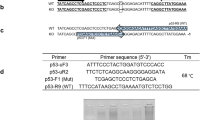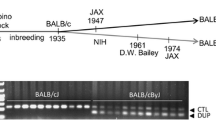Abstract
There are evidences to show that response to ionizing radiations have genetic influence. To investigate this further, reciprocal F1 hybrids were genereted by crossbreeding the radiation-susceptible BALB/c mouse strain with resistant C57BL/6 in a sex-specific manner (BALB/c ♂× C57BL/6 ♀ = B6BcF1; C57BL/6 ♂ × BALB/c ♀ = BcB6F1). These hybrids were compared with each other and to the parental strains with respect to transcriptional responses to low-dose ionizing radiation exposure (LDIR). The two F1 hybrids showed drastic differences in their gene expression profiles to ionizing radiation exposure particularly in case of the genes involved in DNA damage response and repair process. Also, the inheritance pattern of the gene expression was found to be complex and could not be explained solely on the basis of parental expression pattern. It was concluded that there is a differential transmission of susceptible trait alleles from the parents to F1 progeny which is dependent on the sex of the parent mouse strain used to set up the crosses and other environmental factors.







Similar content being viewed by others
References
Albrecht H., Durbin-Johnson B., Yunis R., Kalanetra K. M., Wu S., Chen R., Stevenson T. R. et al. 2012 Transcriptional response of ex vivo human skin to ionizing radiation: comparison between low- and high-dose effects. Radiat. Res. 177, 69–83.
Committee to Assess Health Risks from Exposure to Low Levels of Ionizing Radiation; National Research Council 2006 Health risks from exposure to low levels of ionizing radiation: BEIR VII Phase 2. The National Academies Press, Washington, USA.
Deng C. and Wang R. 2003 Roles of BRCA1 in DNA damage repair: a link between development and cancer. Hum. Mol. Genet. 12, R113–123.
Deobagkar D. and Kelkar A. 2009 A novel method to assess the full genome methylation profile using monoclonal antibody combined with the high throughput based microarray approach. Epigenetics 6, 1–7.
Ding L. H., Shingyoji M., Chen F., Hwang J. J., Burma S., Lee C. et al. 2005 Gene expression profiles of normal human fibroblasts after exposure to ionizing radiation: a comparative study of low and high doses. Radiat. Res. 164, 17–26.
Fachin A. L., Mello S. S., Sandrin-Garcia P., Junta C. M., Donadi E.A., PassosG. A. et al. 2007 Gene expression profiles in human lymphocytes irradiated in vitro with low doses of gamma rays. Radiat. Res. 168, 650–665.
Hanson W. R., Fry R. J., Sallese A. R., Frischer H., Ahmad T. and Ainsworth E. J. 1987 Comparison of intestine and bone marrow radiosensitivity of the BALB/c and the C57BL/6 mouse strains and their B6CF1 offspring. Radiat. Res. 110, 340–352.
Huang D. W., Sherman B. T. and Lempicki R. A. 2009 Systematic and integrative analysis of large gene lists using DAVID bioinformatics resources. Nat. Protocol. 4, 44–57.
James S. and Makinodan T. 1988 T cell potentiation in normal and autoimmune-prone mice after extended exposure to low doses of ionizing radiation and/or caloric restriction. Int. J. Radiat. Biol. 53, 137–152.
Jeggo P. 2009 Risks from low dose/dose rate radiation: what an understanding of DNA damage response mechanisms can tell us. Health Phys. 97, 416–425.
Jeggo P. 2010 The role of the DNA damage response mechanisms after low-dose radiation exposure and a consideration of potentially sensitive individuals. Radiat. Res. 174, 825–832.
Mi H., Nan Guo N., Kejariwal A. and Thomas P. D. 2006 PANTHER version 6: protein sequence and function evolution data with expanded representation of biological pathways. Nucleic Acids Res. 35, D247–252.
Mukherjee S., Sainis K. B. and Deobagkar D. D. 2010 Comparative analysis of gene expression profiles in BALB/c and C57BL/6 strains of mice in response to low-dose ionizing radiation using microarray. Int. J. Low Radiat. 7, 306–323.
Mukherjee S., Sainis K. B. and Deobagkar D. D. 2011 Identification of methylated genes in BALB/c mice liver using monoclonal antibody combined with the high-throughput cDNA microarray approach. Current Sci. 101, 66–72.
Pandey R., Shankar B. S., Sharma D. and Sainis K. B 2005 Low dose radiation induced immunomodulation: effect on macrophages and CD8 + T cells. Int. J. Radiat. Biol. 81, 801–812.
Sankaranarayanan K. and Chakraborty R. 1995 Cancer predisposition, radiosensitivity and the risk of radiation-induced cancers. Radiat. Res. 143, 121–143.
Sankaranarayanan K. and Wassom J. S. 2005 Ionizing radiation and genetic risks. XIV. Potential research directions in the postgenome era based on knowledge of repair of radiation-induced DNA double-strand breaks in mammalian somatic cells and the origin of deletions associated with human genomic disorders. Mutat. Res. 578, 333–370.
Shankar B., Premchandran S., Bharambe S., Sundaresan P. and Sainis K. B. 1999 Modification of immune response by low dose ionizing radiation: role of apoptosis. Immunol. Lett. 68, 237–245.
Snijders A. M., Marchetti F., Bhatnagar S., Duru N., Han J., Hu Z. et al. 2012 Genetic differences in transcript responses to low-dose ionizing radiation identify tissue functions associated with breast cancer susceptibility. PLoS One 7, e45394.
Storer J. B., Mitchell T. J. and Fry R. J. 1988 Extrapolation of the relative risk of radiogenic neoplasms across mouse strains and to man. Radiat. Res. 114, 331–353.
Strickland P. T. and Swartz R. P. 1987 Inheritance of susceptibility to phototumorigenesis and persistent hyperplasia in F1 hybrids between SENCAR mice and BALB/c or C57BL/6 mice. Cancer Res. 47, 6294–6296.
Sudprasert W., Navasumrit P. and Ruchirawat M. 2006 Effects of low-dose gamma radiation on DNA damage, chromosomal aberration and expression of repair genes in human blood cells. Int. J. Hyg. Environ. Health. 209, 503–511.
Tubiana M., Aurengo A., Averbeck D. and Masse R. 2006 Recent reports on the effect of low doses of ionizing radiation and its dose-effect relationship. Radiat. Environ. Biophys. 44, 245– 251.
Wang H. P., Long X. H., Sun Z. Z., Rigaud O., Xu Q. Z., Huang Y. C. et al. 2006 Identification of differentially transcribed genes in human lymphoblastoid cells irradiated with 0.5 Gy of gammaray and the involvement of low dose radiation inducible CHD6 gene in cell proliferation and radiosensitivity. Int. J. Radiat. Biol. 82, 181–190.
Wu J., Lu L. and Yu X. 2010 The role of BRCA1 in DNA damage response. Protein Cell 1, 117–123.
Xie D., Nakachi K., Wang H., Elashoff R. and Koeffler H. P. 2001 Elevated levels of connective tissue growth factor, WISP-1, and CYR61 in primary breast cancers associated with more advanced features. Cancer Res. 61, 8917–8923.
Yu Y., Okayasu R., Weil M. M., Silver A., McCarthy M., Zabriskie R. et al. 2001 Elevated breast cancer risk in irradiated BALB/c mice associates with unique functional polymorphism of the Prkdc (DNA-dependent protein kinase catalytic subunit) gene. Cancer Res. 61, 1820–1824.
Yun M. H. and Hiom K. 2009 Understanding the functions of BRCA1 in the DNA-damage response. Biochem. Soc. Trans. 37, 597–604.
Author information
Authors and Affiliations
Corresponding author
Additional information
[Mukherjee S., Sainis K. B. and Deobagkar D. D. 2014 F1 hybrids of BALB/c and C57BL/6 mouse strains respond differently to low-dose ionizing radiation exposure. J. Genet. 93, xx–xx]
Rights and permissions
About this article
Cite this article
MUKHERJEE, S., SAINIS, K.B. & DEOBAGKAR, D.D. F1 hybrids of BALB/c and C57BL/6 mouse strains respond differently to low-dose ionizing radiation exposure. J Genet 93, 667–682 (2014). https://doi.org/10.1007/s12041-014-0422-8
Received:
Revised:
Accepted:
Published:
Issue Date:
DOI: https://doi.org/10.1007/s12041-014-0422-8




